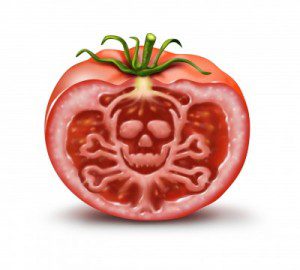By Sayer Ji
Contributing Writer for Wake Up World
Hormones and/or hormone-mimicking chemicals are omnipresent environmental contaminants. Already found in places as varied as our teeth (dental sealant) to our paper products (receipts, money), our meat to our canned foods, new research now indicates that even fresh, whole vegetables and fruits are no longer immune to this growing biological and chemical threat.
A newly released study has found that a variety of substances with hormone-disrupting properties now widely contaminate commercially available fresh vegetables and fruits, in some cases at concentrations exceeding the recommended acceptable daily intake (ADI) for children as recommended by the Joint FAO/WHO Expert Committee on Food Additives (JECFA).
Published this month in the Journal of Agricultural and Food Chemistry, researchers at the Indian River Research and Education Center, University of Florida/IFAS, found the synthetic endocrine-disrupting chemicals bisphenol A (BPA), nonylphenol (NP), and the natural steroidal estrogen 17-β-estradiol, in vegetables and fruits randomly sampled from local markets, using gas chromotagraphy with tandem mass spectrometry.[i]
[pro_ad_display_adzone id=”110028″]
According to the researchers, the “BPA was detected in all vegetable and fruit samples, ranging from 0.2 ±0.1 to 9.0 ±4.9 µg kg-1, indicating significant exposure potential for humans.” Nonylphenol (NP), a chemical in the alkylphenol class mainly used to manufacturer detergents, was detected in pumpkin, sweet potato, citrus, and apple samples. Concentrations of 17-β-estradiol in vegetables and fruits ranged from 1.3 ±0.4 to 2.2 ±1.0 µg kg-1 except those in tomato and strawberry.
Notably, the highest concentrations of BPA were found in potatoes, lettuce contained the highest concentration of natural estrogens, and pumpkin the highest concentration of alkylphenols (APs).
How Did These Chemicals End Up In Our Food?
The answer is wastewater and sewage sludge — two things that, as many would be surprised to find, are commonly used to grow our food. While wastewater may contain as much as 95% water, the other 5% remaining is a biological and chemical atrocity. Even the sewage used in this degenerate, albeit highly productive (though unsustainable), form of farming has been renamed and transformed euphemistically into “biosolids,” to make it somehow sound more palatable.
The reuse of wastewater for irrigation of agricultural land is a well established practice that introduces many contaminants into our environment and crops including pharmaceuticals, hormones and personal care products.
Wastewater may contain human sewage, industrial site drainage, toxic waste (e.g. pesticide manufacturing), petroleum waste products or byproducts, for instance.
Other wastewater constituents include:
- Pathogens such as bacteria, viruses, parasites
- Soluble organic materials such as urea, drugs, pharmaceuticals
- Macro-solids such as condoms, needles, diapers, sanitary napkins
- Emulsions such as paint, adhesives, hair colorants
- Gases such as hydrogen sulfide, methane, carbon dioxide
- Animals such as insects, protozoa, small fish
It is estimated that 90% of the global wastewater being used in agriculture today is untreated, meaning that it contains hundreds, if not thousands of potential biological and chemical toxicants that may ultimately end up in your food and body.
With the increasing use of raw or processed sewage to grow conventional food, it has become prone to overgrowth with pathogenic (even deadly) bacteria, which is why the USDA promotes food irrad iation to nuke (“cold pasteurize”) the intrinsically unsanitary food into the kind of sterility that also entails the destruction of its nutrition value.
Even when sewage is pretreated in order to remove chemicals, foreign materials, and microorganisms, up to 93% of highly concentrated active drug compounds still remain, including hormones and hormone metabolites that remain biologically active.[ii]
With the latest research now indicating that our modern, industrialized agricultural system is creating a toxic nightmare within our food, it is time for us to face the gravity of the situation, and make some real changes. All the more reason to support organically, and preferably locally, produced food by voting with our fork, as it does not utilize these intrinsically toxic farming practices.
Article Resources
- [i] Jian Lu, Jun Wu, Peter J Stoffella, Patrick Wilson. Analysis of Bisphenol A, Nonylphenol and Natural Estrogens in Vegetables and Fruits Using Gas Chromatography-Tandem Mass Spectrometry. J Agric Food Chem. 2012 Dec 6. Epub 2012 Dec 6. PMID: 23215552
- [ii] Watershedcouncil.org, Medicines in Our Waterways
Recent articles by Sayer Ji
- The Evidence-Based Healing Properties of 13 Common Fruits
- Why You Should Ditch Sugar In Favor of Honey
- Dental Composites for Kids: Even Worse Than Mercury Amalgam?
- 13 Evidence-Based Medicinal Properties of Coconut Oil
- Five Amazing Healing Honey Facts
- Is This Fruit Extract 10,000 Times Better Than Chemotherapy?
About the author:
Sayer Ji is the founder and director of GreenMedInfo.com and an advisory board member at the National Health Federation, an international nonprofit, consumer-education, health-freedom organization. He co-authored the book Cancer Killers: The Cause Is The Cure, and is working on another one with Tania Melkonian titled EATomology: An Edible Philosophy of Food.
[pro_ad_display_adzone id=”110027″]








